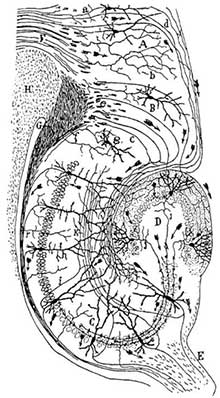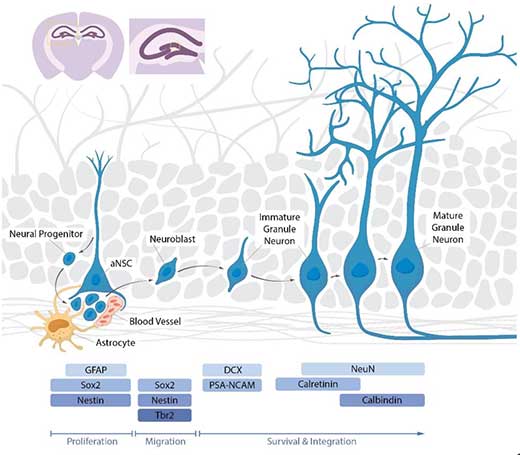It is upon us – the zombie apocalypse. Some greedy corporation has tinkered with things they should have left untouched, and a contagion turns every higher organism it contacts into braindead vectors of destruction. We are all doomed.
Wait… what? Why should we all be doomed? That is ridiculous. Preposterous. Hilarious. Like a former colleague of mine would say: "That's a loser attitude". And it shows a precarious misunderstanding of the scientific process and the greater research community. Any corporate product development of that scale will have solid foundations in previous research – peer-reviewed, published, and in the public domain. There will be numerous experts in the field all over the world, and the man-made outbreak will be quickly met with countermeasures and ultimately a cure. But what to do about the tissue damage caused by the zombie bug? Sure, bodies can heal – but brains? Can brains be repaired or even regrown?
Adult Neurogenesis – When New Brain Cells are Born
In short, the answer is no. Not yet, at least. We are as able to regenerate a brain fully or partially as we are able to regrow limbs. However, the brain's capacity for plasticity and repair is vastly higher than historically believed. When the beautiful works of Camillo Golgi (1) and Santiago Ramon y Cajal (2) (Fig.1) laid the groundwork for our understanding of the brain as a complex organ formed of networks of interconnected, specialized cells, it was generally thought to be stable and permanent. A dogma was established that no new neurons were born after birth. Initial works showing that new neurons were generated even after the brain reached full developmental maturity (4) were met with harsh criticism and rejection. It took another couple of decades and a handful of landmark publications to gradually instill and firmly root the concept of new neurons continually emerging throughout adulthood. Nowadays, the concept of adult neurogenesis is widely accepted.

|
Figure 1. Drawing of the neural circuitry of the rodent hippocampus by Santiago Ramón y Cajal (3).
|
We now know that newly formed neurons can be found in many brain regions of the adult mammalian brain, from the hypothalamus, to the striatum, substantia nigra, amygdala, cortex, and even the cerebellum. The most prominent areas of neurogenesis are found in the subventricular zones (SVZ) of the lateral ventricles and the sub-granular zone of the hippocampal dentate gyrus. Here, hundreds of new neurons may be born in a single day.
These neurons arise from a pool of adult neural stem cells (aNSCs) that persists throughout adulthood. These slowly dividing cells undergo asymmetric cell division to retain one adult neural stem cell while spawning one transit-amplifying cell. These neural progenitor cells (NPCs) rapidly amplify to expand cell numbers and then differentiate through a series of differentiation steps into newly generated adult neurons. The freshly formed neurons undergo maturation and integration into the pre-existing neuronal circuitry. Neurons that fail this process undergo apoptotic cell death. Besides neurons, aNSCs can also give rise to glial cells, both astrocytes and myelinating glia.
The Neurogenetic Stem Cell Niche
In the significant neurogenic regions of the adult brain, aNSCs are embedded into minuscule, well-organized pockets of cells, termed stem cell niches. Here, aNSCs can be found in close proximity to NPCs and in contact with blood vessels and astrocytes. The niche provides a protected microenvironment that allows the stem and progenitor cells to thrive and survive thanks to nutrients and survival signals while guaranteeing that the various signals, which regulate stem cell proliferation and differentiation, can reach the cells.
These signals stem from a wide variety of sources. Locally, astrocytes and microglia provide trophic support and regulatory signals in the form of metabolites, growth factors, cytokines, but also through depositing extracellular matrix, which in turn plays a major role in regulating the activity and fate decisions of stem cells, progenitors, and maturing neurons. Global signals emanate from blood vessels to provide steering input related to stress or inflammatory responses.
The Neurogenic Regions of the Brain
The areas in which neurogenesis occurs in the brain vary greatly between different mammalian species. The SVZ for example, is highly active generating thousands of new neuronal cells in the brain of mice and rats. The emerging neuroblasts – early, undifferentiated, but lineage-committed neuronal cells – form a string of cells, the rostral migratory stream, from the mouse SVZ to the olfactory bulbs, where they integrate as mature neurons and play an essential role in olfaction, especially in learning and memory related to smell. Humans show a comparably much reduced neurogenic activity in the SVZ, and only a few new neurons are formed in the human olfactory bulbs. Instead, neuroblasts contribute to the formation of new neurons in the adjacent striatum of the human brain. In dolphins, however, a mammalian species devoid of olfaction and the respective brain structures, neurogenic activity is completely absent from the SVZ. (5)

|
Figure 2. Adult Neurogenesis in the Hippocampus
|
The dentate gyrus of the hippocampus is probably the most conserved neurogenic region within mammals (Fig.2). Here, the aNSC is the type 1 or radial glia-like (RGL) cell, named after its morphological and biological similarities with radial glia. These stem cells populate the central nervous system during its development. These cells maintain stemness through various factors, with sex-determining region Y-box 2 (Sox 2) playing a central role. Sox2 controls the expression of Sonic hedgehog (Shh) and inhibits Wnt signaling, thereby maintaining a proliferative state. RGL cells give rise to intermediate neural progenitors (INP), which rapidly amplify and feed a pool of neuroblasts, the earliest lineage-committed neuronal cell type. The neuroblasts migrate along the granular cell layer of the dentate gyrus. During this phase, brain-derived neurotrophic factor (BDNF) is vital for survival. Once at their final destination, the cells mature into neurons and integrate into the preformed circuitry. Neuronal cell differentiation is driven by transcription factors neuronal differentiation 1 (NeuroD1), prospero-related homeobox, and cAMP-response element-binding (CREB).
The Role of Neurogenesis
Neurogenesis and the formation and integration of mature neurons in the hippocampus play crucial roles in its cognitive functions. Especially crucial is neurogenesis for learning and memory, as the formation of new memories, spatial orientation, and pattern separation is closely linked to the successful integration of newly formed neurons. Furthermore, neurogenesis also affects the response to anxiety, stress regulations, and specific aspects of social behavior. Given the brain functions that hippocampal neurogenesis is crucial to, it is not surprising that several external stimuli strongly influence the amount of neurogenesis. Behavioral enrichment and learning are associated with enhanced neuroblast differentiation and survival of maturing neurons. On the other hand, physical exercise enhances the proliferation of neural stem and progenitor cells, while stress has strong detrimental effects on cell proliferation and impairs neurogenesis.
The roles of SVZ neurogenesis outside of olfaction and the roles of other neurogenic regions of the brain are currently less clear. However, the plasticity and flexibility of neurogenesis in scenarios of disease, inflammation, and injury are remarkable. For example, the rostral migratory stream of neuroblasts in rodents completely breaks down, and newly born SVZ- and dentate gyrus-derived cells are redirected to cortical regions in mouse models of demyelination and Multiple Sclerosis. Interestingly, these SVZ-born cells mostly differentiate into astrocytes and myelinating glia, instead of neurons, demonstrating that the neurogenic niches have untapped central nervous system repair potential beyond the formation of new neurons.
Adult neurogenesis is as fascinating as it is enigmatic. The hopes that a better understanding of the various aspects of neurogenesis will lead to new ways to heal the brain are high. Maybe one day we can regrow brains and cure zombies.
Neurosciences at Enzo
Enzo Life Sciences offers a comprehensive product portfolio for
Neuroscience and
Stem Cell-focused research. At Enzo, we believe in providing scientists with novel tools that will help your research on neurogenesis and its cellular basis.
Do you have any questions regarding our products' implementation into your research? Don't hesitate to contact our
Technical support team for more information. We will be happy to assist.











